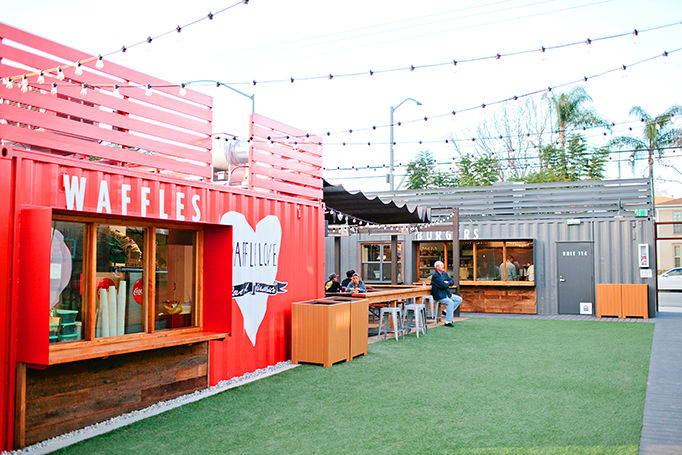
A dirt lot in suburban Long Beach, Calif., has been transformed into a thriving retail center built from cargo containers. This retail center, called SteelCraft, boasts eight food-themed vendors and is the first such center in Los Angeles County. The project is the concept of Kimberly Gros, a Long Beach native and entrepreneur who derived the name by juxtaposing the words “steel” (a nod to the container material that houses each tenant) and “craft” (in recognition of the artisan nature of the vendors). SteelCraft opened early last month, over Super Bowl weekend.
The tenants are DeSano Pizza Bakery, The Fresh Shave, Lovesome Chocolates, Pig Pen Delicacy, Smog City Brewing, Steelhead Coffee, Tajima Ramen and Waffle Love. The refurbished containers were provided by Gardena, Calif.–based International Port Management Enterprise.
“These are basically food trucks without the wheels,” said Mark Turpin, owner of Long Beach–based Turpin Design, which designed the project. The containers house kitchens and serving areas around a 170-foot-long courtyard that seats 150 and has a performance stage.
Gros, who lives mere blocks from SteelCraft and whose background is in human resources and recruiting, is anything but a conventional retail developer. She came up with the SteelCraft idea three years ago, after doing some traveling overseas. “Typically, you fall in love with cities that have restaurants or vendors that create community space,” said Gros. “What makes Long Beach different is that our economy is driven through the Port of Long Beach. Our staple item is the container itself, so I just started dreaming of what it would look like to use containers to create that type
of community, and the project just came alive.”
Initially, her idea was to locate one container in downtown Long Beach, but over time the vision grew. For a year and a half Gros met weekly with Brian Ulaszewski, executive director of City Fabrick, a local nonprofit urban design studio, to consult on the design. Once she had something tangible on paper, she spoke with business development leaders around the city, finally connecting with the Bixby Knolls Business Improvement Association, which serves the Bixby Knolls neighborhood, a few miles north of downtown Long Beach. “They directed us to a piece of property that they thought was ideal, and through that, we got connected with its owner, Martin Howard, of Howard CDM, probably the best general contractor in Long Beach,” said Gros. “They too felt the project was exciting, and we all joined forces.”
For attracting tenants, Gros was able to draw upon her recruiting and human-services skills. “Recruiting is very similar to what I do now in regards to finding the best candidates and the best vendors to come into our space and share our vision,” Gros said. “When we were looking at vendors, we tried to figure out what we needed, what was lacking from the city. We wanted to provide an offering that you couldn’t find anywhere else.”
She focused on three themes. “We wanted to bring in tenants that value the community,” said Gros. “We also celebrate the crafts, so I didn’t want just anybody that could pay rent — they had to create their craft, and it had to be second to none. And finally, they needed to celebrate restoration and old things and giving it a new story or sustainability.”
SteelCraft is the most recent of several retail centers that utilize shipping containers in this way — there are already some operating in Las Vegas, in London, in South Korea, and in Dubai, United Arab Emirates, among other places. “I get probably 10 referrals a week for projects that people want to do with containers,” said Turpin. He currently has two more projects in the works in California: another in Long Beach, and one in Oceanside. “It is going to be a very popular thing, at least for a while, if not for the long term,” Turpin said. “We have literally millions of containers in ports around the world. All of these containers are sitting around, and people are trying to figure out what to do with them.”
The Los Angeles Regional Code Compliance Program, which serves Long Beach and Huntington Beach as well as Los Angeles and other cities in Southern California, is developing standardized code-compliance and development programs so that it can approve more container-based projects within communities.
Meanwhile, connecting with tenants and with the neighborhood remains Gros’ top priority. “We meet with our tenants every week to talk about what’s working and what’s not working,” she said. “We have each other’s backs in this project, and that has been the coolest part of the whole thing. The culture that it has created is very inviting, and I feel like we have started to create a space that people in the community feel very proud of, and it is their own. They have watched us develop for the past year and a half, so they feel very, very invested into it.”
This success has Gros scouting three locations in other U.S. cities. “They are all different from one another, and we are looking at sites with parking. I have a long list of possible tenants, but the decision is really around where we are going to open.”
It is important to think beyond any sort of cookie-cutter approach, Gros says. “It isn’t like a basic design, and everybody takes it and goes,” she said. “We want to figure out the neighborhood and what it is lacking and then build what it needs. We want to make it affordable for new tenants coming in that might just be chefs right out of college, that have a really great product but don’t have half a million dollars to open a space.”